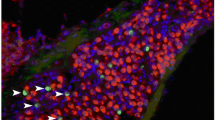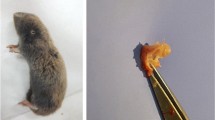Summary
To our knowledge this is the first transmission electron-microscopic study on endochondral bone formation in the otic capsule. The formation of the rat's globuli ossei and interglobular spaces is studied with special regard to Manasse's (1897) contributions who suggested the globuli ossei's cells to be “embryonic cartilage cells” which have “metaplased” to bone cells. Since then his opinion has found ample confirmation by subsequent light-microscopic works until today.
The results reported here indicate that the chondrocytes of the erosive zone die in the endochondral layer of the otic capsule. Mononuclear cells ahead of the invasion front partially resorb the remnants of the intercellular substances. Cells which originate from perivascular elements of invasive capillary buds enter the empty lacunae of the cartilage remnants and become osteoblasts. They form the globuli ossei by producing bone matrix and become osteocytes later on.
Zusammenfassung
Dies ist die erstmalige elektronenmikroskopische Untersuchung der enchondralen Ossifikation der Labyrinthkapsel. Am Beispiel der Ratte (Rattus norwegicus L.) wird die Entstehung der Globuli ossei und der Interglobularräume untersucht. Nach Eröffnung der Lakunen schlüpfen die Chondrozyten aus. Einkernige Zellen, die der Invasionsfront vorangehen, räumen die verbliebene knorpelige Interzellularsubstanz teilweise ab.
Die leeren Lakunen der stehengebliebenen Knorpelreste werden von polyedrischen, basopohilen Zellen eingenommen. Diese stammen aus dem perivaskulären Gewebe einsprossender Kapillaren, haben ein ausgeprägtes feingranuläres Retikulum und werden zu Osteoblasten. Sie bilden die Matrix der Globuli ossei. Später werden sie Osteozyten, deren Fortsätze nicht in die Grundsubstanz des Interglobularraums hineinziehen.
Similar content being viewed by others
Literatur
Bast T (1930) Ossification of the otic capsule in human fetusses. Contrib Embryol Carneg Instn 121:53–82
Bast T, Anson BJ (1949) The temporal bone and the ear. Thomas, Springfield Ill
Beck C (1979) Anatomie und Histologie des Ohres. In: Berendes J, Link R, Zöllner F (Hrsg) HNO-Heilkunde in Praxis und Klinik, Bd. 5. Thieme, Stuttgart, S 92–94
Bohatirchuk FP (1969) Metaplasia of cartilage into bone — a study by stain historadiography. Am J Anat 126:243–254
Brighton Ct, Ray RD, Soble LW, Kuettner KE (1969) In vitro epiphyseal-plate growth in various oxygen tensions. J Bone Joint Surg (Br) 7:1383–1396
Eckert-Möbius A (1926) Mikroskopische Untersuchungstechnik und Histologie des Gehörorgans. In: Denker A, Kahler O (Hrsg) Handbuch der HNO-Heilkunde. Bd 6/1. Springer Bergman, München, S 211–359
Gegenbaur C (1864) Über die Bildung des Knochengewebes. Jena Z med Naturw 1:343–369
Güssen R (1967) Globuli interossei as a manifestation of bone resorption. Acta Otolaryngol (Stockh) 63:411–423
Hall BK (1970) The origin of cartilage and bone from common stem cells. Calcif Tissue Res [Suppl] 4:147
Hall BK (1972) Immobilization and cartilage transformation into bone in the embryonic chick. Anat Rec 173:391–404
Hildmann H (1977) Autoradiographische, tierexperimentelle Untersuchungen an der Schneckenkapsel des Kaninchens. Laryngol Rhinol Otol (Stuttg) 56:508–512
Kolmer W (1927) Das Gehörorgan. In: Möllendorff W von (Hrsg) Handbuch der mikroskopischen Anatomie des Menschen. Springer, Berlin, S 410–413
Knese KH (1979a) Stützgewebe und Skelettsystem. In: Möllendorff W von, Bargmann W (Hrsg) Handbuch der mikroskopischen Anatomie des Menschen, Bd II/1. Springer, Berlin Heidelberg New York, S 1–683
Knese KH (1979b) Fibrillenreifung und intraossale Osteogenese als Grundlage der Entwicklung der Lamellen- und Osteonstruktur. Gegenbaurs Morphol Jahrb. 125:15–37
Knese KH (1980a) Die Knorpelgefäße und der Knochenkern, II. Mitteilung. Der metamorphosierende Knorpel. Gegenbaurs Morphol Jahrb 126:86–101
Knese KH (1980b) Zell- und Fibrillenmetamorphose während der Bildung des Knochenkerns, III. Mitteilung. Der metamorphosierende Knorpel. Gegenbaurs Morphol Jahrb 126:631–647
Lindsay R (1980) Otosclerosis. In: Paparella M, Shumrick D (eds) Otolaryngology, vol II. Saunders, Philadelphia, pp 1619–1644
Manasse P (1897) Über knorpelhaltige Interglobularräume in der menschlichen Labyrinthkapsel. Z Ohrenheilkd 31:1–22
Meyer M (1927) Über eine eigentümliche Art von Knochengewebe beim erwachsenen Menschen (den lamellenlosen, feinfaserigen — strähnenartigen — Markknochen) und über den embryonalen Markknochen. Z Anat Entwicklungsgesch 83:734–751
Meyer M (1933) Die normale Anatomie der menschlichen Labyrinthkapsel. Z Hals-Nasen-Ohrenheilkd 33:1–72
Miller ML, Basom CR, McCuskey RS (1972) Temporary lobulation in cartilagenous models of long bones. Anat Rec 172:523–528
Rauchfuss A (1978) Neue Befunde zum Bau der enchondralen Schicht des Labyrinthknochens. Verh Anat Ges 73:1029–1030
Rauchfuss A (1979a) The vascular mantles of labyrinthine bone. A comparative anatomical study. Arch Otorhinolaryngol 224:301–311
Rauchfuss A (1979b) Vascularization of the endochondral layer with respect to the otic capsule. Acta Anat (Basel) 105:233–241
Rauchfuss A (1980a) The interglobular spaces in the endochondral layer. A comparative anatomical study. Acta Anat (Basel) 107:389–398
Rauchfuss A (1980b) Some morphological details of the endochondral layer of labyrinthine bone. Arch Otorhinolaryngol 226:239–250
Rauchfuss A (1981) Ein Beitrag zur Entwicklung der Gehörknöchelchen und des Ringbandes. Arch Otorhinolaryngol 233: (im Druck)
Shin-Izi Ziba (1911) Über die chondrometaplasmatische Osteogenese. Z Morphol Anthropol 13:157–179
Steinberg L (1936) Verteilung und Lage der knorpelhaltigen Interglobularräume. Arch Ohren-Nasen-Kehlkopfheilkd 135:187–211
Trueta J (1963) The role of vessels in osteogenesis. J Bone Joint Surg (Br) 45B: 402–418
Weidenreich F (1930) Das Knochengewebe. In: Möllendorff W von (Hrsg) Handbuch der mikroskopischen Anatomie des Menschen, Bd II/2. Springer, Berlin, S 403–410
Wilsman NJ, van Sickle DC (1970) The relationship of cartilage canals to the initial stages of osteogenesis of secondary centers of ossification. Anat Rec 168:381–392
Zawisch-Ossenitz C (1927) Über Inseln von basophiler Substanz in den Diaphysen langer Röhrenknochen. Z Mikrosk Anat Forsch 10:473–526
Author information
Authors and Affiliations
Rights and permissions
About this article
Cite this article
Rauchfuss, A. Zur enchondralen Ossifikation der Labyrinthkapsel: Die Entstehung der Globuli ossei und der Interglobularräume. Arch Otorhinolaryngol 233, 237–250 (1981). https://doi.org/10.1007/BF00454388
Received:
Accepted:
Issue Date:
DOI: https://doi.org/10.1007/BF00454388




